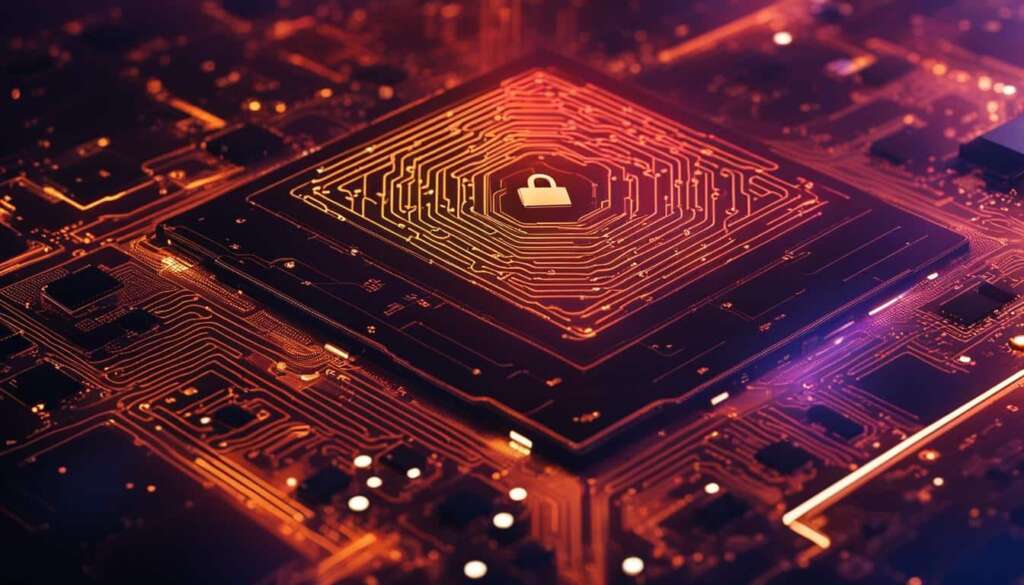Table of Contents
Governments and public sector bodies are facing an unprecedented challenge in today’s digital age. The reliance on technology for the safe and effective functioning of a country has increased significantly. However, this reliance also exposes governments to significant cybersecurity risks.
Cyber attacks not only threaten the digital world but also critical infrastructure such as energy, water, and transport systems. Protecting this infrastructure and ensuring data privacy is of utmost importance. Governments need to be proactive in addressing emerging threats, implementing robust risk management processes, and developing comprehensive cybersecurity solutions.
With the growing importance of cybersecurity in government sectors, it is crucial to prioritize government cybersecurity and data protection. By doing so, we can safeguard sensitive information, maintain public trust, and ensure the smooth operation of essential public services.
Emerging Cyber Threats to Critical Infrastructure
Governments and public sector bodies must be vigilant not only against familiar cyber threats but also against emerging ones that pose significant risks to critical infrastructure. In the digital age, cybercriminals are becoming increasingly sophisticated, employing tactics such as Advanced Persistent Threats (APTs) to infiltrate systems. State-sponsored actors and organized criminal groups target critical infrastructure, which includes sectors like energy, transportation, and water, aiming to disrupt essential services and compromise data security.
The increasing adoption of Internet of Things (IoT) devices in critical infrastructure has created additional entry points for cybercriminals. These interconnected devices, while enhancing efficiency and automation, also present vulnerabilities that can be exploited. Moreover, ransomware attacks targeting critical infrastructure have been on the rise, posing a significant challenge to governments and public sector bodies.
To effectively combat these emerging cyber threats, governments must prioritize robust risk management and proactive cybersecurity measures. Threat intelligence must be continuously gathered and analyzed to identify potential vulnerabilities and anticipate new attack vectors. Comprehensive risk mitigation strategies should be implemented, focusing on securing critical infrastructure, enhancing incident response capabilities, and fostering collaboration among government agencies, critical infrastructure operators, and cybersecurity experts.
Examples of Emerging Cyber Threats
| Cyber Threat | Impact |
|---|---|
| Advanced Persistent Threats (APTs) | Stealthy infiltration of critical systems, data theft, and potential disruption of essential services. |
| Ransomware Attacks | Encryption of critical data, rendering it unusable until a ransom is paid, leading to financial losses and disruption of services. |
| IoT Exploitation | Compromise of interconnected devices in critical infrastructure, leading to potential disruptions and unauthorized access to sensitive data. |
| Supply Chain Attacks | Infiltration of trusted suppliers’ systems to gain unauthorized access to critical infrastructure. |
The table above illustrates some examples of emerging cyber threats to critical infrastructure. These threats require a proactive and multifaceted approach to cybersecurity, emphasizing continuous monitoring, comprehensive risk assessment, and strong incident response capabilities. Governments must remain agile and vigilant in adapting their cybersecurity strategies to counter these evolving threats effectively.
Robust Risk Management and Governance
In order to effectively protect government and public sector data from cyber threats, robust risk management and governance practices must be implemented. This includes adopting a risk-based approach to cybersecurity, prioritizing resources based on the severity and likelihood of cyber risks.
Governments and public sector bodies should develop and implement comprehensive national cybersecurity solutions that address critical information and infrastructure protection, incident response, and collaboration frameworks. By establishing mechanisms for sharing threat intelligence among various entities, including government agencies and critical infrastructure operators, collective defense capabilities can be enhanced.
Furthermore, it is crucial for governments to establish dedicated national cybersecurity centers responsible for coordinating cybersecurity solutions and providing technical support. These centers can serve as central hubs for monitoring, analyzing, and responding to cyber threats, ensuring a proactive and coordinated approach to cybersecurity.
Key Elements of Robust Risk Management and Governance:
- Risk-based approach to cybersecurity
- Comprehensive national cybersecurity solutions
- Sharing threat intelligence
- Dedicated national cybersecurity centers
Benefits of Robust Risk Management and Governance:
Robust risk management and governance practices provide governments and public sector bodies with a structured and proactive approach to cybersecurity. By prioritizing resources based on risk severity and likelihood, implementing comprehensive cybersecurity solutions, and sharing threat intelligence, governments can enhance their defense capabilities against cyber threats. The establishment of dedicated national cybersecurity centers further strengthens the ability to monitor, analyze, and respond to cyber threats.”
Table: Key Components of Robust Risk Management and Governance
| Components | Description |
|---|---|
| Risk-based approach | Adopting a proactive approach to cybersecurity by prioritizing resources based on risk severity and likelihood. |
| Comprehensive cybersecurity solutions | Developing and implementing national cybersecurity solutions that address critical information and infrastructure protection, incident response, and collaboration frameworks. |
| Sharing threat intelligence | Establishing mechanisms for sharing threat intelligence among government agencies and critical infrastructure operators to enhance collective defense capabilities. |
| Dedicated national cybersecurity centers | Establishing centralized cybersecurity centers responsible for coordinating cybersecurity solutions and providing technical support. |
By prioritizing robust risk management and governance practices, governments can strengthen their cybersecurity posture and protect critical data from evolving cyber threats.
Continued investment in risk management, cybersecurity governance, and threat intelligence sharing is essential to stay ahead of cyber threats and ensure the security and resilience of government and public sector data.
Sector-Specific Cybersecurity Guidance
Governments play a critical role in ensuring the cybersecurity of their respective nations. To effectively protect critical infrastructure and sensitive data, governments should develop sector-specific cybersecurity guidance. This guidance should be tailored to the unique requirements of different critical infrastructure sectors, such as energy, transportation, and healthcare. By establishing sector-specific cybersecurity standards and regulations, governments can promote consistent implementation of cybersecurity solutions and best practices.
One of the key benefits of sector-specific cybersecurity guidance is that it provides clear and focused recommendations for organizations within each sector. These recommendations can cover a wide range of cybersecurity measures, including access controls, data classification, encryption, incident response protocols, and employee awareness training. By following these guidelines, organizations can better protect their systems and data against cyber threats.
Furthermore, sector-specific cybersecurity guidance can also help regulators and auditors assess the cybersecurity posture of regulated entities within each sector. Regular assessments can ensure that organizations comply with established security standards and continuously improve their cybersecurity capabilities. This proactive approach to cybersecurity regulation can significantly enhance the overall cybersecurity resilience of critical infrastructure sectors.
The Benefits of Sector-Specific Cybersecurity Guidance:
- Promotes consistent implementation of cybersecurity solutions and best practices
- Provides clear and focused recommendations for organizations within each critical infrastructure sector
- Improves the cybersecurity posture of regulated entities through regular assessments
- Enhances the overall cybersecurity resilience of critical infrastructure sectors
| Table: Sector-Specific Cybersecurity Guidance Framework | |
|---|---|
| Framework Element | Description |
| Cybersecurity Standards | Establishing clear and comprehensive cybersecurity standards tailored to each critical infrastructure sector |
| Regulatory Compliance | Ensuring organizations within each sector comply with established cybersecurity regulations |
| Threat Intelligence Sharing | Promoting collaboration and sharing of cyber threat intelligence among organizations within each sector |
| Incident Response | Developing sector-specific incident response protocols to handle cybersecurity incidents effectively |
“Sector-specific cybersecurity guidance is essential for protecting critical infrastructure sectors and ensuring the resilience of nations against cyber threats.” – Cybersecurity Expert
In conclusion, sector-specific cybersecurity guidance is crucial for protecting critical infrastructure sectors and ensuring the resilience of nations against cyber threats. By establishing clear cybersecurity standards, promoting regulatory compliance, and fostering collaboration within each sector, governments can create a robust cybersecurity framework. This framework will enable organizations to implement effective cybersecurity measures and protect critical infrastructure and sensitive data from evolving cyber threats.

Advanced Monitoring and Incident Response
Governments need to deploy advanced monitoring solutions to ensure real-time detection and response to cyber threats. With the increasing sophistication of cyber attacks, traditional security measures may not be sufficient to protect critical infrastructure and sensitive data. Advanced monitoring tools enable proactive threat hunting and continuous monitoring of network traffic, identifying anomalies and potential security breaches. These solutions use advanced analytics and machine learning algorithms to detect and analyze patterns, enabling early detection of cyber threats.
In addition to advanced monitoring, governments must also establish effective incident response capabilities. Incident response plans should be well-defined and regularly tested through simulated exercises to ensure a rapid and coordinated response in the event of a cyber attack. Designated response teams should be trained and equipped to handle different types of incidents, minimizing the impact and facilitating swift recovery. Incident response should follow predefined procedures, including containment, eradication, and recovery steps, to minimize data loss and operational disruptions.
Implementing real-time detection and incident response capabilities is crucial for effective cybersecurity in the public sector. Governments should leverage advanced monitoring tools and establish robust incident response frameworks to detect, analyze, and mitigate cyber threats promptly.
| Benefits of Advanced Monitoring and Incident Response |
|---|
| Early detection of cyber threats |
| Proactive threat hunting |
| Rapid response and containment of security breaches |
| Minimized data loss and operational disruptions |
| Enhanced incident response capabilities |
Real-life Example:
“The advanced monitoring system deployed by the XYZ government detected a sophisticated cyber attack targeting critical infrastructure. Thanks to their real-time detection capabilities, they were able to quickly identify the attack, analyze its origins, and take immediate steps to contain the breach. This incident demonstrated the importance of advanced monitoring and incident response in safeguarding critical infrastructure and protecting sensitive data.” – Cybersecurity Analyst, XYZ Government
Creating a Culture of Cybersecurity Awareness
Governments and public sector bodies need to prioritize cybersecurity awareness and education to mitigate the risks posed by cyber threats. Training employees, stakeholders, and the general public is crucial in promoting a culture of cybersecurity awareness and proactive risk mitigation. By investing in effective employee training programs, governments can equip their workforce with the necessary knowledge and skills to identify and respond to cyber threats.
Employee training should cover various aspects of cybersecurity, including email security, as emails are a common source of infiltration for cybercriminals. Training sessions can educate employees on how to recognize phishing emails, suspicious attachments, and potentially harmful links. By raising awareness about these threats, governments can reduce the likelihood of successful cyber attacks and protect their sensitive data.
Another crucial aspect of creating a culture of cybersecurity awareness is the implementation of strong authentication methods. Governments should encourage the use of multi-factor authentication, such as biometrics or security tokens, to enhance overall security. This provides an additional layer of protection and minimizes the risk of unauthorized access to critical systems and data.
“Investing in cybersecurity awareness and education initiatives is an essential step towards building a resilient and secure digital ecosystem.”
Additionally, governments should consider implementing email encryption and signing to protect the confidentiality and integrity of sensitive information. These measures ensure that emails are only accessed by authorized recipients and cannot be altered during transmission. By adopting these security measures, governments can strengthen their overall cybersecurity posture and inspire confidence in their citizens.
Table: Key Components of Cybersecurity Awareness Training
| Training Component | Description |
|---|---|
| Email Security | Training employees on how to identify and respond to phishing emails, suspicious attachments, and potentially harmful links. |
| Strong Authentication | Promoting the use of multi-factor authentication methods, such as biometrics or security tokens. |
| Email Encryption and Signing | Implementing measures to protect the confidentiality and integrity of sensitive information in emails. |
Investment in Immutability for Data Protection
In recent years, there has been a significant increase in ransomware attacks targeting government organizations. These attacks can have devastating consequences, causing data loss and disruption to critical services. To effectively combat this threat, governments must invest in immutability for data protection.
Immutability refers to the capability of data to remain unaltered and unchangeable. By implementing technologies like immutable snapshots, governments can ensure that their data is protected from unauthorized deletion or modification. This provides a secure and accessible backup that can be used to restore systems and recover from successful attacks.
Investing in immutability for data protection offers several benefits. Firstly, it ensures that sensitive government data remains intact and uncompromised, safeguarding the privacy and security of citizens. Secondly, it provides a reliable means of recovering from ransomware attacks, minimizing downtime and reducing the impact on critical services. Additionally, immutability helps to meet regulatory requirements for data integrity and retention.
“Immutability is a crucial defense against ransomware attacks. By investing in technologies that preserve the integrity of data, governments can protect their critical infrastructure and ensure the continuity of public services.” – Cybersecurity Expert
| Benefits of Investing in Immutability | Explanation |
|---|---|
| Protection against ransomware attacks | Immutability ensures that data cannot be deleted or modified, providing a secure backup for recovery. |
| Data privacy and security | Immutability safeguards sensitive government data, protecting the privacy of citizens. |
| Compliance with regulations | Immutability helps governments meet regulatory requirements for data integrity and retention. |
By investing in immutability for data protection, governments can enhance their cybersecurity posture and mitigate the risks posed by ransomware attacks. This proactive approach not only safeguards critical infrastructure and sensitive data but also instills public trust in government services.
Embracing Ease of Use for Data Management
In today’s digital age, effective data management is crucial for governments and public sector bodies. To streamline processes and enhance productivity, it is essential to prioritize ease of use when selecting data management systems. By investing in user-friendly solutions, government agencies can eliminate the complexities of data silos and empower their IT teams to focus on strategic initiatives rather than routine storage management.
Easy-to-use data management systems offer several advantages for government organizations. They simplify data access and retrieval, allowing employees to quickly locate and utilize the information they need. This not only saves time but also enhances overall productivity, enabling government workers to deliver efficient and effective services to the public.
Furthermore, implementing user-friendly data management systems can lead to significant cost savings. By reducing the need for extensive IT support and training, governments can allocate their resources more efficiently. The time and financial savings associated with intuitive data management solutions contribute to improved operational efficiency and better utilization of public funds.

The Benefits of Embracing Ease of Use for Data Management:
- Streamlined processes and increased productivity
- Improved data access and retrieval
- Cost savings through reduced IT support and training
“Investing in user-friendly data management systems is a win-win for government organizations. Not only does it simplify operations and boost productivity, but it also leads to substantial cost savings in the long run.”
By prioritizing ease of use in data management, governments can unlock the full potential of their valuable information assets. Embracing intuitive systems not only enhances operational efficiency but also improves the overall user experience for government employees, enabling them to provide better services to the public.
| Benefits | Advantages |
|---|---|
| Streamlined processes | Increased productivity |
| Improved data access | Quicker information retrieval |
| Cost savings | Reduced IT support and training expenses |
Deploying Scalable Storage Solutions
The public sector is experiencing exponential data growth, driven by the increasing reliance on technology in critical infrastructure. As connected devices become more prevalent, the need for scalable storage solutions has become paramount. Governments must implement storage systems that can accommodate large volumes of data without requiring costly upgrades or compromising critical infrastructure operations.
Scalable storage solutions provide the flexibility and expandability needed to manage data growth effectively. These systems allow for seamless capacity expansion, ensuring that government agencies can store and access data without limitations. By investing in scalable storage solutions, governments can optimize data management processes, streamline operations, and ensure the availability and integrity of critical information.
To illustrate the importance of scalable storage solutions, the following table provides a comparison of traditional storage systems versus scalable storage solutions:
| Traditional Storage | Scalable Storage Solutions |
|---|---|
| Limited storage capacity | Flexible capacity expansion |
| Costly upgrades to accommodate data growth | Seamless scalability without additional expenses |
| Compromised data accessibility during capacity limitations | Uninterrupted access to stored data |
| Inefficient data management due to storage constraints | Optimized data handling and processing |
By deploying scalable storage solutions, governments can effectively manage the ever-increasing volume of data in critical infrastructure while ensuring that operations remain uninterrupted. These solutions provide a foundation for efficient data management, enabling government agencies to meet the storage demands of the digital age.

Strengthening Cybersecurity Measures for Citizens’ Trust
Governments hold a significant responsibility in ensuring the protection of sensitive citizen data and maintaining public trust. With the increasing reliance on technology in delivering government services, it is crucial to prioritize robust cybersecurity measures. By implementing effective security measures for e-government platforms, governments can safeguard personal data and enhance data integrity and access security.
A security culture should be fostered within government organizations, focusing on implementing zero trust security principles. This approach ensures that every user and device is considered a potential threat, requiring strong authentication methods and encryption to prevent unauthorized access to sensitive data. By adopting these measures, governments can establish a secure and trustworthy environment for citizens to interact with online services and platforms.
In addition to technical measures, cybersecurity awareness and education initiatives play a vital role in strengthening citizens’ trust. Training programs should be implemented to educate employees, stakeholders, and the general public on best practices for cybersecurity. By raising awareness and promoting proactive risk mitigation, governments can empower individuals to keep their personal data secure and contribute to a safer digital environment.
Priorities for Strengthening Cybersecurity Measures:
- Implement strong authentication methods and encryption for e-government platforms.
- Promote a security culture within government organizations and adopt zero trust security principles.
- Invest in cybersecurity awareness and education initiatives to empower citizens in protecting their personal data.

| Benefits of Strengthening Cybersecurity Measures | Actions Taken |
|---|---|
| Enhanced trust in government services | Implementing strong authentication methods and encryption for e-government platforms |
| Reduced risk of data breaches | Promoting a security culture within government organizations |
| Increase in cybersecurity awareness | Investing in cybersecurity awareness and education initiatives |
Conclusion
The public sector faces increasing cybersecurity risks as reliance on technology grows. Protecting critical infrastructure, implementing robust risk management processes, and promoting cybersecurity awareness are vital for defending against cyber threats. Governments must invest in immutability for data protection, utilize easy-to-use data management systems, deploy scalable storage solutions, and strengthen cybersecurity measures for citizens’ trust. By adopting a comprehensive approach to cybersecurity, the public sector can mitigate risks and protect sensitive public data.
In today’s digital age, the public sector must be vigilant in safeguarding data and systems from cyber attacks. The ever-evolving threat landscape poses significant challenges, requiring governments to stay ahead of the curve. By prioritizing data protection and risk management, governments can fortify critical infrastructure and enhance resilience against cyber threats.
Furthermore, promoting a culture of cybersecurity awareness is key to mitigating risks. Through employee training, stakeholder engagement, and public education initiatives, governments can empower individuals to recognize and respond to potential threats. This collective effort fosters a safer digital environment and builds trust between citizens and public sector organizations.
In conclusion, cybersecurity in the public sector is an ongoing battle that requires constant vigilance and adaptation. By investing in advanced technologies, robust governance structures, and comprehensive cybersecurity solutions, governments can navigate the evolving threat landscape and safeguard sensitive public data. Protecting critical infrastructure and fostering a culture of cybersecurity awareness are crucial for maintaining the public’s trust and ensuring a secure digital future for all.
FAQ
What are the main cybersecurity risks faced by governments and public sector bodies?
Governments and public sector bodies are exposed to significant cybersecurity risks, including cyber attacks that can impact critical infrastructure and compromise data privacy.
What are some emerging cyber threats to critical infrastructure?
State-sponsored actors and organized criminal groups may employ sophisticated Advanced Persistent Threats (APTs) to infiltrate systems. The increasing adoption of Internet of Things (IoT) devices in critical infrastructure also introduces additional entry points for cybercriminals. Ransomware attacks targeting critical infrastructure are also on the rise.
How should governments prioritize cybersecurity measures?
Governments should adopt a risk-based approach to cybersecurity and prioritize resources based on the severity and likelihood of cyber risks. They should also develop and implement comprehensive national cybersecurity solutions, establish mechanisms for sharing threat intelligence, and establish dedicated national cybersecurity centers responsible for coordinating cybersecurity solutions.
What sector-specific cybersecurity solutions should governments develop?
Governments should develop sector-specific cybersecurity solutions and guidance tailored to the unique requirements of critical infrastructure sectors. These solutions should promote consistent implementation of cybersecurity solutions and best practices.
How can governments enhance their incident response capabilities?
Governments should deploy advanced monitoring solutions to detect and respond to cyber threats in real-time. They should also develop effective incident response plans with predefined procedures and designated response teams, regularly testing the plan’s effectiveness through review exercises.
How can governments promote a culture of cybersecurity awareness?
Governments should prioritize cybersecurity awareness and education initiatives at all levels. This includes training employees, stakeholders, and the general public on email security, implementing zero trust security measures, strong authentication methods, and email encryption and signing.
How can governments protect sensitive data from ransomware attacks?
Governments should invest in immutability for data protection, utilizing technologies like immutable snapshots that provide secure and accessible backups. This ensures that data cannot be deleted or altered, allowing for quick recovery from successful attacks.
How can governments streamline data management processes?
Governments should prioritize ease of use when selecting data management systems, eliminating the complexity of data silos and streamlining processes. This reduces the burden on IT teams, increases productivity, and allows for a focus on strategic initiatives.
How can governments accommodate significant data growth in critical infrastructure?
Governments should deploy scalable storage solutions that allow for easy expansion without requiring expensive upgrades. This prevents capacity limitations and ensures that critical infrastructure can handle the increasing amount of data generated.
Why is strengthening cybersecurity measures important for maintaining citizens’ trust?
Governments must prioritize cybersecurity measures to protect sensitive citizen data and maintain public trust. This includes implementing security measures for e-government platforms, creating a security culture within organizations, and focusing on zero trust security, strong authentication methods, and email encryption.
What are the main goals of government cybersecurity?
The main goals of government cybersecurity are to protect critical infrastructure, implement robust risk management processes, promote cybersecurity awareness, and ensure the protection of sensitive public data.
Source Links
- https://federalnewsnetwork.com/commentary/2023/03/3-ways-governments-can-better-protect-public-data/
- https://www.openaccessgovernment.org/prevent-protect-detect-cybersecurity-solutions-government-bodies/163571/
- https://ingroupe.com/insights/public-sector-cybersecurity-risks/













